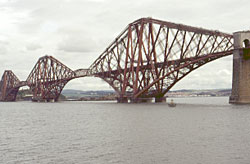 |
 |
|||||
FORTH RAIL BRIDGE
 The huge cantilever sections of the rail bridge spanning The Forth are
one of the most familiar landmarks of Scotland. Completed in 1890,
the bridge was constructed from 54,000 tonnes of steel, 194,000 tonnes
of stone and concrete, and in excess of 21,000 tonnes of cement. This
was the largest steel bridge in the world, using approximately 7,500,000
rivets produced by The Clyde Rivet Company. Success was not without
its casualties and, throughout the course of construction, 57 men lost
their lives.
The huge cantilever sections of the rail bridge spanning The Forth are
one of the most familiar landmarks of Scotland. Completed in 1890,
the bridge was constructed from 54,000 tonnes of steel, 194,000 tonnes
of stone and concrete, and in excess of 21,000 tonnes of cement. This
was the largest steel bridge in the world, using approximately 7,500,000
rivets produced by The Clyde Rivet Company. Success was not without
its casualties and, throughout the course of construction, 57 men lost
their lives.
This wide expanse of river had always been important to trade, and the crossing was notoriously difficult at times. Storms were often experienced, resulting in the loss of possessions and life, the ferrymen were unreliable, and it was not uncommon to encounter pirates during the eighteenth century. With a steady increase in both passenger and freight traffic, Parliament recognised that action needed to be taken to improve the facilities and make the route safer. Several suggestions were put forward early in the nineteenth century to provide some kind of ‘fixed link’ across The Forth, but it was with the arrival of the railway that discussions became serious. In 1854 Thomas Bouch, a consulting engineer to The North British Railway, submitted his proposals to bridge both The Tay and The Forth. Following initial scepticism, Bouch’s plans for The Tay Bridge were finally given approval in 1864 and construction began in 1871.
By 1873 Bouch had been commissioned to design The Forth Bridge, similar in concept to his original drawings of the late 1850s. With The Tay Bridge under construction, work on the new Forth bridge was delayed for five years, but the foundation stone was eventually laid in 1878. Thomas Bouch had subsequently received a Knighthood for his Tay crossing, but his career ended abruptly in December 1879 when the bridge collapsed in a violent storm, resulting in the death of 75 people. Pending an enquiry into the safety aspects of Bouch’s design, work was immediately halted on his Forth suspension bridge.
When The Forth Bridge Railway Company were formed in 1882 to construct and operate the new bridge, they adopted the rather radical design proposed by Benjamin Baker and Sir John Fowler. Parliamentary consent was given in July to begin construction on the innovative cantilever structure, and the contract was awarded to William Arrol on 21st December. The three main cantilevers were completed and in place by 1887, but the final operation of joining the girder booms to close the gaps rested on the prevailing climate. In less than eight years The Forth Rail Bridge was completed, the official opening ceremony being performed by HRH The Prince of Wales on 4th March 1890. On this prestigious occasion, attracting members of the Royal Family, MPs, consultant engineers from home and abroad, and directors from other railway companies, The Prince of Wales placed the final gilded rivet in place.
Today the bridge, now a ‘listed structure’, still carries about 150 trains each day across The Forth, and has been regularly maintained over the years. An extensive five-year refurbishment programme was undertaken at the turn of the millennium, costing in excess of £40m, and employing somewhere between 150 and 300 men per day, six days a week. At an average height above the general water level of some 361ft ( m), the exposed conditions can prove very hazardous but latest techniques, and anti-corrosion products, have greatly reduced the maintenance involved. It used to be said that as soon as the painting team had reached the far side of the bridge, it was time to start over at the beginning.
